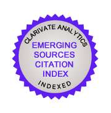La diversidad y los usos mixtos en los entornos culturales y creativos como impulsores de la participación ciudadana y la sostenibilidad: análisis del St. George’s Cultural Quarter (Leicester, Reino Unido)
DOI:
https://doi.org/10.22530/ayc.2023.23.635Palabras clave:
Distritos culturales y creativos, espacios urbanos, participación ciudadana, industrias creativas, cultura, usos mixtosResumen
Los distritos culturales y creativos son espacios urbanos fundamentales para el desarrollo cultural y la promoción de la creatividad en una ciudad. En este estudio, se examina la importancia de la diversidad y de los usos mixtos en estos distritos, centrándose en el caso de estudio del St. George's Cultural Quarter en Leicester, Reino Unido. Se destaca cómo la combinación de diferentes actividades culturales y creativas, junto con la diversidad de actores involucrados en las mismas, contribuye al fomento de la participación ciudadana y a la revitalización de la zona. A través de un análisis detallado de este caso de estudio, se identifican las estrategias exitosas para impulsar la cohesión social y la sostenibilidad en estos espacios. Para ello, en esta investigación se presentan diferentes actividades desarrolladas por espacios como el LCB Depot, Leicester Print Workshop, el Curve Theatre, el Centro de Medios digitales Phoenix y el Chutney Ivy.
Citas
AAH SAKULA ARCHITECTS (2004). Leicester Creative Business Depot. Ash Sa-kula Architects.
ARCHELLO (2015). Leicester Print Workshop. www.archello.com/project/leicester -print-workshop
ATHENA (2023). Página web oficial. www.athenacb.co.uk/about-us/history
AUMENTE, P. (2016). La metamorfosis del concepto de barrio artístico en dinámicas de distrito cultural. En Chaves Martín, M. A., y Lorente, J. P., (Eds.). Barrios Artísticos y distritos culturales: nuevos espacios para la creati-vidad y la revitalización urbana (163-228). Icono 14.
BBC (2009). Report critical of theatre costs. news.bbc.co.uk/2/hi/uk_news/ england/leicestershire/8258653.stm
BELANDO, M. V. S., ULLDEMOLINS, J. R., y ZARLENGA, M. I. (2012). ¿Ciudad creativa y ciudad sostenible?: Un análisis crítico del “modelo Barcelona” de políticas culturales. Revista Crítica de Ciências Sociais, (99), 31-50. https://doi.org/10.4000/rccs.5101
BELFIORE, E. (2002). Art as a means of alleviating social exclusion: does it really work? A critique of instrumental cultural policies and social impact studies in the UK. International Journal of Cultural Policy, 8(1), 91–106. https://doi.org/10.1080/102866302900324658
BELL, D. y JAYNE, M. (2004). City of quarters: urban villages in the contemporary city. Ashgate. https://doi.org/10.4324/9781315260181
BIANCHINI, F. (1995). Night cultures, night economies. Planning Practice & Research, 10(2), 121-126. https://doi.org/10.1080/02697459550036667
BLUEPRINT (2009). Phoenix Square, Leicester. www.blueprintregeneration.com/ project/phoenix-square-leicester
BORJA, J. (2003). Ciudadanía y globalización. Centro de Documentación en Políticas Sociales de Buenos Aires.
CHATTERTON, P. y HOLLANDS, R. (2002). Theorising urban playscapes: pro-ducing, regulating and consuming youthful nightlife city spaces. Urban Studies, 39, 95-116. https://www.jstor.org/stable/43196748
CULTURAL QUARTER HERITAGE (2015). Página web oficial del proyecto. https://culturalquarterheritage.wordpress.com/the-project
CURVE (2023). Página web oficial. www.curveonline.co.uk
CUTTLEFISH MULTIMEDIA Ltd (2015). The Cultural Quarter App. https://web.archive.org/web/20160123145111/http://culturalquarter.co.uk/
DIXON, S. (2013). Changing Industries in Leicester´s Cultural Quarter (2013). www.youtube.com/watch?v=GbyWsy99M28
EVANS, G. (2001). Cultural planning: an urban renaissance? Routledge.
EVANS, G. y Shaw, P. (2004). The contribution of culture to regeneration in UK: a review of evidence. DCMS.
EXPRESSEUM (2015). Leicester University’s Archives. www.culturalquarterheritage. wordpress.com/2015/07/18/leicester-universitys-archives
FELDMANN, N. (2015). Rutland Street. An architectural guide to the Cultural Quarter in Leicester. Feldmann Architects.
FERILLI, G. y SACCO, P.L. (2012). Nuevas direcciones en políticas culturales. Los distritos culturales sistémicos. Doble J.
FLEMING, T. (2015). Creative Industries Sector Growht Plan for Leicester and Leicestershire. Leicester & Leicestershire Enterprise Partnership.
FLORIDA, R. (2002). The rise of the creative class and how it´s transforming work, leisure, community and everyday life. Basic Books.
GARCÍA CARRIZO, J. (2021a). City branding. Fundamentos y aplicaciones de mar-ca en espacios cu lturales y creativos. Fragua.
GARCÍA CARRIZO, J. (2021b). Globalización, gentrificación y falta de partici-pación ciudadana: pesadillas de los distritos culturales y creativos. En Nogueira, M.X. y Agrelo Costas, E. (eds.), Cidadanía e identidades. Ex-presións políticas, económicas e culturais no século XXI, Cadernos CIPPCE sobbre Emerxencia Cultural, nº 6 (pp. 109-123). Santiago de Compostela: Universidad de Santiago de Compostela. https://dx.doi.org/10.15304/9788418445415
GARCÍA CARRIZO, J. y GRANGER, R.C. (2020). Cultural and Creative Districts as Spaces for Value Change. En Granger, R.C. (ed.) Value Construction in the Creative Economy. Negotiating Innovation and Transformation (pp. 177-198). Springer International Publishing - Palgrave Macmillan. https://doi.org/10.1007/978-3-030-37035-0
GLAESER, E. (2013). Triumph of the city: How our greatest invention makes us richer, smarter, greener, healthier, and happier. Penguin Books.
GORLENKO, A. (2022). Leicester Print Workshop: Refurbishment of 1970s ware-house to provide workshops for one of the country’s leading print facilities. www.ajbuildingslibrary.co.uk/projects/display/id/7906
GRANGER, R. (2017). The Sustainability of the Creative Industries: Leicester and London. De Montfort University Centre for Urban Austerity.
GRANGER, R. (2019). Creative Splintering and the Rise of Municipal Creative Economies. De Montfort University.
HARVEY, J. (2014). Silverscreen Primary Education at Phoenix. is-suu.com/phoenixsquareleicester/docs/silver_screen_education
HULME, T. (2013). The Changing Industries guide. https://web.archive.org/web/20200220002502/http://empedia.info/maps/170
JACOBS, J. (2011). Muerte y vida de las grandes ciudades. Capitan Swing.
JONES, B. (2018). Spectacular new venue to launch in Leicester's Cultural Quar-ter. leicestermercury.co.uk/whats-on/whats-on-news/spectacular-new-venue-launch-leicesters-2012983
KOTLER, N., & KOTLER, P. (2007). Can museums be all things to all people?: Missions, goals, and marketing's role. In Museum management and market-ing (pp. 313-330). Routledge. https://doi.org/10.1080/09647770000301803
LANDRY, C. (2000). The creative city: a toolkit for urban innovators. Earhscan.
LANDRY, C., Greene, L., Matarasso, F., y Bianchini, F. (1996). The art of regen-eration. Urban renewal through cultural activity. Comedia.
LCB DEPOT (2015). 31 Rutland Street, Leicester. LCB Depot.
LCB DEPOT (2022). Página web oficial. www.lcbdepot.co.uk/contact-us
LCB DEVELOPMENT (2014). LCB 10. www.youtube.com/watch?v=gtZ wnLBMchs&t=1s
LEICESTER CITY COUNCIL (2014). St. George´s Cultural Quarter. Action Plan (2016-2020). Leicester City Council. www.leicester.gov.uk/media/183943/st-georges-cultural-quarter-action-plan.pdf
LEICESTER CITY COUNCIL (2022). Story of Leicester. www.storyofleicester.info
LEICESTER PRINT WORKSHOP (2016). Leicester Print Workshop's New Building Wins Three Prestigious Prizes. www.leicesterprintworkshop.com/about_us/ news/142
LEICESTER PRINT WORKSHOP (2022). Página web oficial. www.leicesterprintworkshop.com
LORENTE, J.P. (1997). Espacios de arte contemporáneo generadores de revitaliza-ción urbana. Centros de arte, museos, arte público, talleres, estudios y galerías. Focos “artísticos” de revitalización urbana, espacios para el sincretismo. Uni-versidad Zaragoza. www.u.arizona.edu/~compitel/Espacios%20de%20Arte%20Contemporaneo.pdf
MARK, L. (2016). Leicester Print Workshop by Takero Shimazaki Architects. www.architectsjournal.co.uk/buildings/leicester-print-workshop-by-takero-shimazaki-architects/10006420.article
MARKUSEN, A. (2006). Urban development and the politics of a creative class: evidence from a study of artists. Environment and planning A, 38(10), 1921-1940. https://doi.org/10.1068/a38179
MARTÍNEZ-FLORES, V., ROMO-AGUILAR, M., y CÓRDOVA-BOJÓRQUEZ, G. (2015). Participación ciudadana y planeación del ordenamiento territorial en la frontera norte de México. Espiral, 22(64), 189-220. https://www.redalyc.org/pdf/138/13840666006.pdf
MERLI, P. (2002). Evaluating the social impact of participation in arts activi-ties: a critical review of Francois Matarasso Use or Ornament? Interna-tional Journal of Cultural Policy, 8(1), 107–118. http://dx.doi.org/10.1080/10286630290032477
MILES, S. (2005). Our Tyne: iconic regeneration and the revitalisation of identity in Newcastle Gateshead. Urban Studies, 42, 913-926. https://doi.org/10.1080/00420980500107326
Muxí, Z. y Gutiérrez, B. (2011). Apuntes sobre Jane Jacobs. En Jacobs, J., Muerte y vida de las grandes ciudades (pp. 7-14). Capitan Swing.
ONS (Office for National Statics) (2017). Digital, Culture, Media & Sport Sec-tor Estimates 2017: Gross Value Added. www.gov.uk/government/statistics/ dcms-sectors-economic-estimates-2017-gva
PAISAJE TRANSVERSAL (2019). Escuchar y transformar la ciudad: urbanismo cola-borativo y participación ciudadana. Los libros de la Catarata.
PEGDEN, T. (2019). Shock as sister bars The Exchange and Queen Victoria Arts Club close without notice. www.leicestermercury.co.uk/news/leicester-news/shock-sister-bars-exchange-queen-3454336
PHOENIX (2018). Phoenix. Anual Report 2017/18. www.phoenix.org.uk//content/uploads/2018/12/Phoenix-Annual-Report-2017-18-WEB.pdf
PHOENIX (2022). Página web oficial. www.phoenix.org.uk
Potts, J. y CUNNINGHAM, S. (2010). Four Models of the Creative Industries. International Journal of Cultural Policy, 120 (1), 163-180. http://dx.doi.org/10.1080/10286630802281780
ROBERTS, M. (2006). From “creative city” to “no-go areas” – the expansion of the night-time economy in British town and city centres. Cities, 23, 331–338. https://doi.org/10.1016/j.cities.2006.05.001
RODGER, R. y MADGIN, R. (2016). Leicester, a modern history. Carnegie Pub-lishing.
SAKULA, A. (2010). LCB Bus depot as we found it. www.youtube.com/watch?v=OJ7LOUMB2aM
SAN MARTIN, P., y ANDRÉS, G. (2021). Creativa Monumento: Mediatización y sostenibilidad del paisaje cultural. La trama de la Comunicación, 25, 123-141. http://ref.scielo.org/s6jhc4
SOULSBY, C. (2017). Queen Victoria Arts Club Leicester - Business Plan. Leices-ter.
STAFFORD, C. (2017). Take a tour of Leicester Curve. www.youtube.com/watch?v=BdrZnsqkDZI
STAFFORD, C. (2019). Curve. Gender Pay Gap Report 2018. https://issuu.com/curvetheatre/docs/gender_pay_gap_report_2018
TALLON, A. (2013). Urban regeneration in the UK. Routledge.
TELLSTRÖM, R. (2011). City branding through food culture: insights from the regional branding level. En Dinnie, K. (ed.), City Branding (pp. 62-69). Palgrave Macmillan.
THOMAS, C.J. y BROMLEY, R.D.F. (2000). City-centre revitalisation: problems of fragmentation and fear in the evening and night-time city. Urban Stud-ies, 37, 1407–1433. http://dx.doi.org/10.1080/00420980020080181
TRUEMAN, M. (2012). Leicester's Curve theatre 'most disastrous' project in city's history. www.theguardian.com/stage/2012/aug/09/leicester-curve-theatre-disastrous-mayor
TWO QUEENS (2022). Página web oficial. https://2queens.com/
VISIT ENGLAND (2022). Take the cultural quarter trail in Leicester. https://www.visitengland.com/experience/take-cultural-quarter-trail-leicester
VISIT LEICESTERSHIRE (2022). Chutney Ivy. www.visitleicester.info/food-and-drink/chutney-ivy-p695291
WYNNE, D. (1992). The Culture Industry. The arts in urban regeneration. Ave-bury.
ZUKIN, S. (2011). Naked city. Oxford University Press.
Descargas
Publicado
Cómo citar
Número
Sección
Licencia
Derechos de autor 2023 ARTE Y CIUDAD. Revista de Investigación

Esta obra está bajo una licencia internacional Creative Commons Atribución-NoComercial 4.0.











